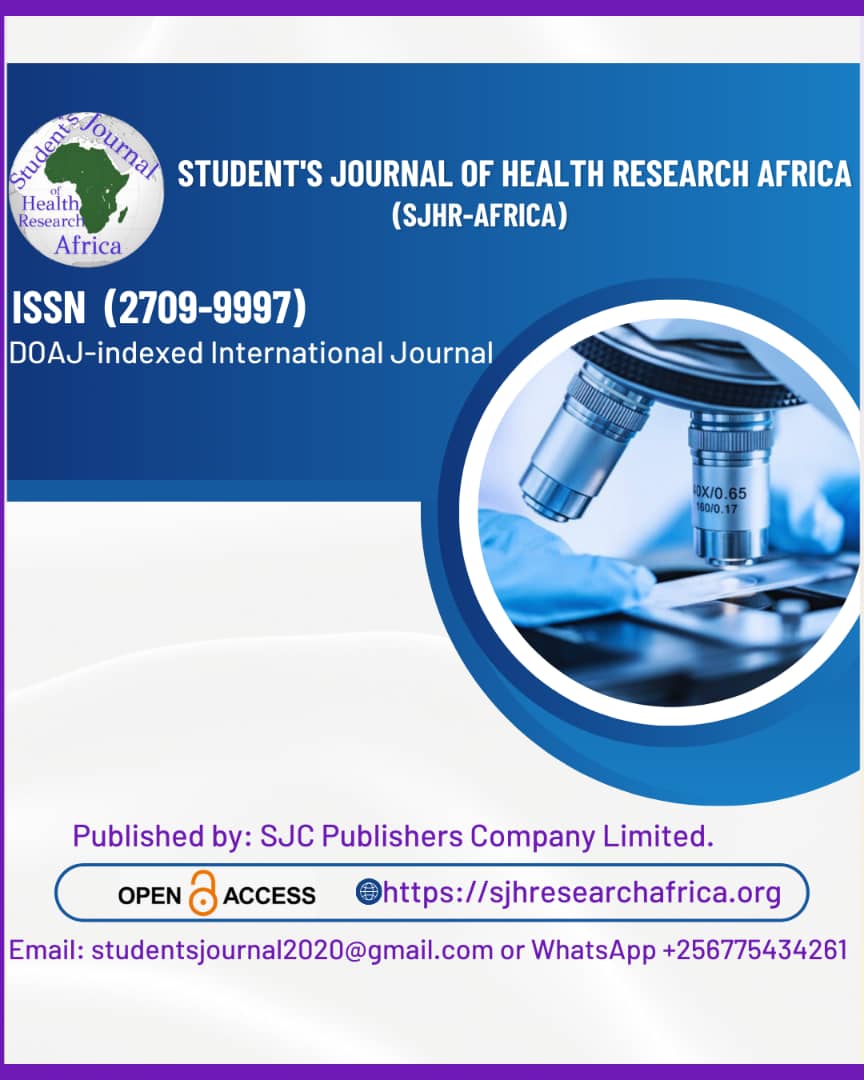PATTERNS OF INFECTIONS AND ANTIMICROBIAL RESISTANCE AMONG GRAM NEGATIVE ORGANISMS IN A TERTIARY CARE HOSPITAL
DOI:
https://doi.org/10.51168/sjhrafrica.v6i3.1584Keywords:
multidrug resistance (MDR), indoor patient department (IPD), outdoor patient department (OPD)Abstract
Introduction
Regional variation in the distribution of various organisms is noted. Monitoring the use of antimicrobials and constant review of sensitivity patterns is imperative. The main aim of this study was to determine the species prevalence of Gram-negative isolates, including antibiotic resistance patterns, from various clinical specimens.
Materials and methods
A hospital-based observational descriptive study was conducted to identify and perform an antibiotic susceptibility test of Gram-negative bacilli from clinical samples. The VITEK 2 Compact (30 card capacity) system was used, where a fluorogenic methodology for organism identification and a turbidimetric method for susceptibility testing was performed. The method used for antimicrobial susceptibility testing was the doubling dilution technique for MIC based on the microdilution method.
Results
A total of 970 clinical samples were received, of which culture positivity was seen in 391(40.3%) cases. The most common specimen was urine at 35.1% (45/128), followed by a blood sample at 27.3% (35/128). The most common isolate was Escherichia coli 36.0% (47/128), followed by Klebsiella pneumoniae 16.4% (21/128) and Burkholderia cepacia 11.7% (15/128). Among the IPD patients, Escherichia coli showed maximum sensitivity to amikacin 67.7% and gentamicin 61.2%; 55.5% of the strains of Acinetobacter baumannii were sensitive to ceftazidime. Pseudomonas aeruginosa was sensitive to cefepime, cefoperazone/sulbactam, and levofloxacin, 70.0% each respectively. 86.6% of strains of Burkholderia cepacia retained susceptibility to meropenem.
Conclusion
This study isolates (lactose-fermenting bacteria) were sensitive to trimethoprim-sulfamethoxazole, levofloxacin, and amoxicillin/clavulanic acid. On the other hand, the non-lactose-fermenting bacteria were susceptible to imipenem, meropenem, and levofloxacin.
Recommendation
Recommendations include strongly preferred alternative drugs for active or combination treatments.
References
Magill SS, Edwards JR, Bamberg W, et al. Multistate point-prevalence survey of healthcare-associated infections. N Engl J Med. 2014;370(13):1198-1208. DOI: 10.1056/NEJMoa1306801. https://doi.org/10.1056/NEJMoa1306801
Sievert DM, Ricks P, Edwards JR, et al. Antimicrobial-resistant pathogens associated with healthcare-associated infections: summary of data reported to the National Healthcare Safety Network at the Centers for Disease Control and Prevention, 2009-2010. Infect Control Hosp Epidemiol. 2013;34(1):1-14. DOI: 10.1086/668770. Epub 2012 Nov 27. https://doi.org/10.1086/668770
Thorpe TC, Wilson ML, Turner JE, DiGuiseppi JL, Willert M, Mirrett S, Reller LB. BacT/Alert: an automated colorimetric microbial detection system. J Clin Microbiol 1990 Jul; 28(7): 1608-12. DOI: 10.1128/jcm.28.7.1608-1612.1990. PMID: 2116451; PMCID: PMC267997. https://doi.org/10.1128/jcm.28.7.1608-1612.1990
Bandy A, Wani FA, Mohammed AH, Dar UF, Mallick A, Dar MR and Tantry BA. Bacteriological profile of wound infections and antimicrobial resistance in selected gram-negative bacteria. Afr Health Sci 2022; 22(4): 576-586. DOI: 10.4314/ahs. v22i4.63 https://doi.org/10.4314/ahs.v22i4.63
BioMeriux, Inc. 2019. 100 Rodolphe Street Durham, North Carolina 27712 USA. DOI: https://www.biomerioux-usa.com/vitek-2
Rajput K, Johri S, and Goyal A. Identification of Bacterial Isolates and Their Antimicrobial Susceptibility Pattern from Wound/Pus Sample in a Tertiary Care Hospital, Gwalior, India. Annals of the National Academy of Medical Sciences 2023;59(2):97-103. DOI: 10.1055/s-0043-1768136 https://doi.org/10.1055/s-0043-1768136
Mehta A and Dilawar MK. Characterization and antimicrobial susceptibility profile of non-lactose fermenting Gram-negative bacterial isolates in a tertiary care teaching hospital of central India. Asian J Clin Res 2021;14(10):41-47. DOI:10.22159/ajpcr.2021 v14i10.42822 https://doi.org/10.22159/ajpcr.2021.v14i10.42822
Nazneen S, Mukta K, Santosh C, Borde A. Bacteriological trends and antibiotic susceptibility patterns of clinical isolates at Government Cancer Hospital, Marathwada. Ind J of Cancer 2016;53(4):583-586. DOI: 10.4103/ijc.IJC_34_17. https://doi.org/10.4103/ijc.IJC_34_17
Savanur SS, Gururaj H. Study of antibiotic sensitivity and resistance pattern of bacterial isolates in Intensive care unit setup of a tertiary care hospital. Ind J Crit Care Med 2019;23(12):547-555. DOI: 10.5005/jp-journals-10071-23295. https://doi.org/10.5005/jp-journals-10071-23295
Colak M, Asgin N. Antimicrobial resistance profile of Enterobacter cloacae and Klebsiella aerogenes in a tertiary care hospital in Turkey: A five-year study. Med Sci Discovery 2021;8(3):161-166. DOI: https://DOI.org/10.36472/msd.v8i3.501 https://doi.org/10.36472/msd.v8i3.501
Regha IR and Sulekha B. Bacteriological profile and antibiotic susceptibility pattern of lower respiratory tract infections in a tertiary care hospital, Central Kerala. Int J Med Microbiol Trop Dis 2018;4(4):186-190. DOI: https://DOI.org/10.18231/2581-4761.2018.0040 https://doi.org/10.18231/2581-4761.2018.0040
Prasanna S, Dharanidevi S, Das NK and Sathya R. Prevalence, Phenotypic Characterization and Antibiotic Susceptibility of Non-Fermentative Gram-Negative Bacilli Isolates at a Tertiary Care Centre. Int J Curr Microbiol App Sci 2016;5(11): 442-454 https://doi.org/10.20546/ijcmas.2016.511.051
Bhargava K, Nath G, Bhargava A, Kumari R, Aseri GK, and Jain N. Bacterial profile and antibiotic susceptibility pattern of uropathogens causing urinary tract infection in the eastern part of Northern India. Front Microbiol 2022;13:1-9 https://doi.org/10.3389/fmicb.2022.965053
Downloads
Published
How to Cite
Issue
Section
License
Copyright (c) 2025 Priya Kumari, Anamika Singh, Priyanka Paul Biswas, Aninda Sen

This work is licensed under a Creative Commons Attribution-NonCommercial-NoDerivatives 4.0 International License.






















